NORTH WALES COAST
RAILWAY: NOTICE BOARD
Rheilffordd arfordir gogledd Cymru: Hysbysfwrdd
28 February 2011
 Last issue
Last issue Archive
Archive Contributions and comments are encouraged: see the Contributions Page
This site is dedicated to all our regular contributors and supporters, and especially the all rail staff of North Wales.

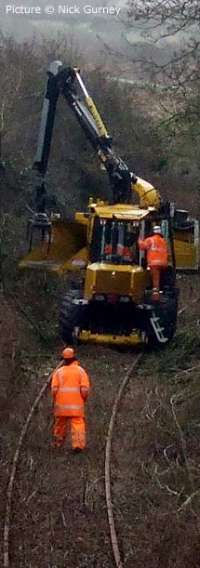
Forthcoming events
March 2011
Friday 4 March Clwyd Railway Circle AGM followed by Photo Competition and Members Night. Members are invited to give a 15 minute presentation of their choice, any format welcomed. Please book your slot no later than 18th February by contacting David Jones (see below for details).
Monday 7 March RCTS Port Sunlight John Day will give a digital presentation on 21st Century Steam featuring steam in the UK, USA, China and the Ukraine.
10 March Llandudno and Conwy Valley Railway Society The last months of the Routemasters with Dr John Willis and 'Society tribute to the late Bill Rear' by Bob Barnsdale and Larry Davies
Friday 11 March Altrincham Electric Railway Preservation Society STEAM AROUND CHESTER FROM THE 1960s ONWARDS a colour slide presentation by John Feild
Monday 21 March RCTS Chester Paul Chancellor FROM BLUE AND GREY TO BLACK AND GREEN. Paul from Colour-Rail presents slides illustrating the wide variety of liveries that have adorned British steam, diesel and electric locomotives over the past 60 years.
Thursday 31 March Merseyside Railway History Group AGM: Members Slides
April 2011
Friday 1 April Clwyd Railway Circle Geoff Morris: The Railways of South-West Wales over the last 30 years. A photographic journey looking at the railway scene in Pembrokeshire, Carmarthenshire and West Glamorgan, an area often neglected by the railway enthusiast. We visit far-flung outposts of the passenger system (Fishguard Harbour, Milford Haven, Pembroke Dock, Central Wales line) and also meet some unusual diesels (cut-down classes 03 & 08) on the way.
Monday 4 April RCTS Port Sunlight BRANCH AGM (Members Only) Followed by Members' Photographs.
Friday 8 April Altrincham Electric Railway Preservation Society
TORNADO - A STEAM LOCOMOTIVE FOR THE 21ST CENTURY
illustrated presentation by Graham Nicholas (A1 Steam Locomotive Trust)
Thursday 14 April Llandudno and Conwy Valley Railway Society "Cardiff Canton Diesel Depot” Steve Morris
Monday 18 April RCTS Chester Geoff Morris: ANOTHER AUSTRALIAN ADVENTURE. A digital presentation of Geoff’s 2010 visit to Australia featuring main line & preserved steam in Victoria, New South Wales & Queensland plus views of the modern scene and the odd kangaroo!
Thursday 28 April Merseyside Railway History Group Richard Kells: Quiz and informal evening
See the Calendar page for more details and later dates.
Above: a Youtube slideshow of some view by 'Corrie' taken in early February, including a visit to Holyhead by a Class 70.
Cefn freight resumes
The Cefn viaduct on the Shrewsbury - Wrexham line is now open again to all traffic, as from 24 February.
Wrexham and Shropshire in exile - report by Sion Owen
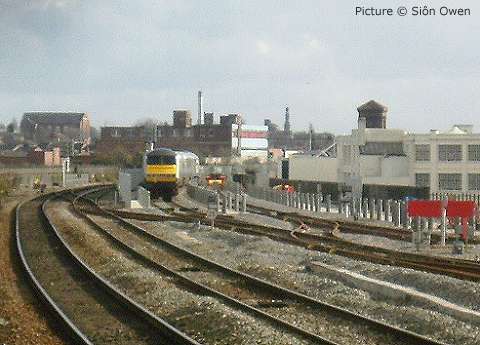
Wrexham & Shropshire rolling stock continues in use on a Chiltern Railways diagram: the pictures from 22 February show the view from the platforms at Birmingham Moor Street of the train stabled in the sidings.
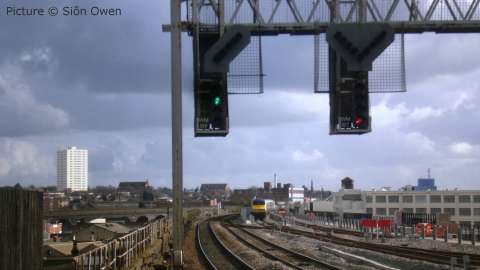
Unfortunately the only way to get a close shot of it was from a train to Small Heath and back but I didn't get anything worthwhile from that.
A poster (left) at Moor Street station explains to passengers how to use the train:
We are introducing a new
timetable, and at the same time we are introducing a new type of train
to the 0546 train to London Marylebone. These trains feature
'Inter-City' type trains which are a little different from our normal
trains.
Unlike the trains you are used to, the doors on these trains are not automatic. When boarding and alighting you will need to open and close them yourself. So, if you're the last on or off the train at your stop, please remember to 'slam' the door shut behind you, after ensuring there is nobody following you. This will help avoid delays to your service.
Please pick up a leaflet for more details about the effects on your regular journey.
Unlike the trains you are used to, the doors on these trains are not automatic. When boarding and alighting you will need to open and close them yourself. So, if you're the last on or off the train at your stop, please remember to 'slam' the door shut behind you, after ensuring there is nobody following you. This will help avoid delays to your service.
Please pick up a leaflet for more details about the effects on your regular journey.
Diplomacy, Arriva style
The Operations Director of Arriva Trains Wales, Peter Leppard, interviewed on the radio as the drivers' strike approached, was asked why train drivers in Wales should be paid less than train drivers in other parts of the UK. There is a great difference between driving high-speed trains and local ones, he opined. 'It's the difference between driving a jumbo jet and a milk float.'
Not a good way to win friends, one might think.
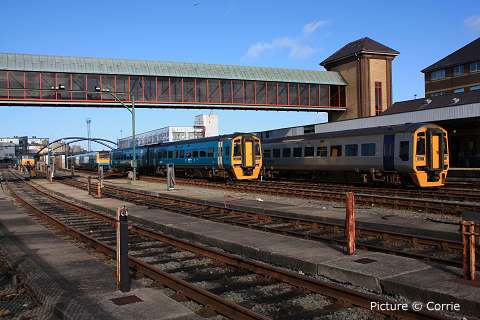
Trains resting at Holyhead, 28 February: no Arriva trains ran, but Virgin did continue to serve North Wales. Picture by Corrie.
Welsh Highland all the way
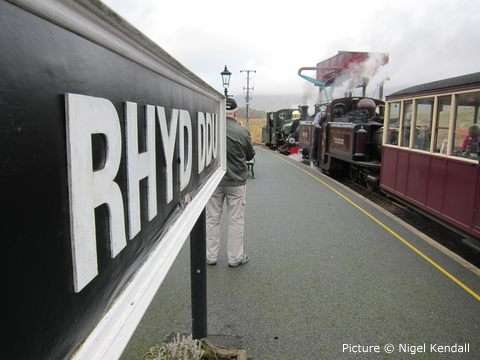
The February half-term week saw Welsh Highland Railway trains operating into Porthmadog Harbour for the first time in public service, while the Ffestiniog Railway's line was blocked for the construction of a bridge over the new road by-pass. Nigel Kendall was aboard the first train from Porthmadog to Caernarfon, seen above at Rhyd Ddu.
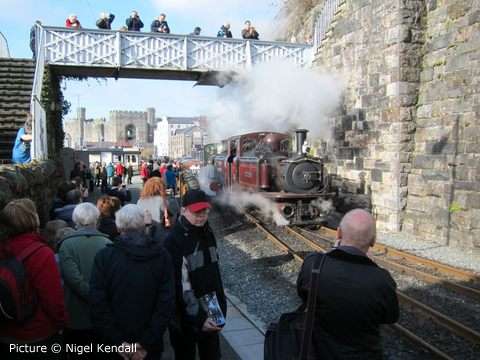
Above: preparing for the return working at Caernarfon. Nigel writes: 'Nigel writes: 'I know Blanche ran services on the WHR when first opened to Dinas but I think this is the first time a double Fairlie in the shape of Merddin Emrys, has been to the town, unless someone knows differently?
Next, some reports from the first few days, starting with Ian Pilkington's view of 19 February:
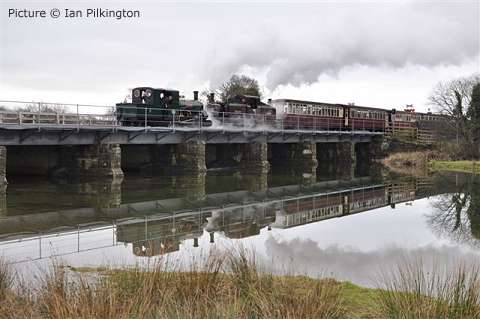
Saturday 19 February: Blanche & Merddin Emrys cross the Glaslyn at Pont Croesor with the 10:45 opening special from Porthmadog to Caernarfon.
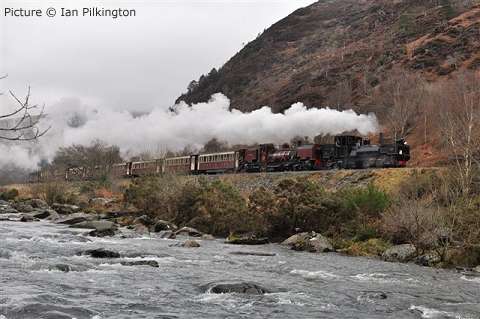
K1 & 138 in the Aberglaslyn Pass with 11:00 opening special from Caernarfon to Porthmadog.
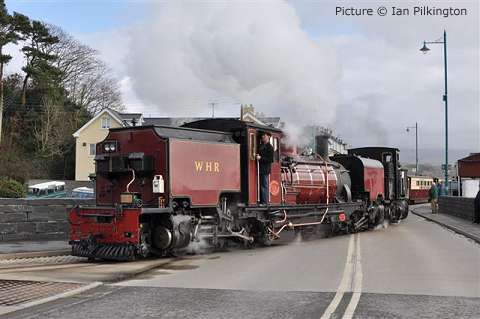
138 & K1 leave Porthmadog with the 14:15 return special to Caernarfon.
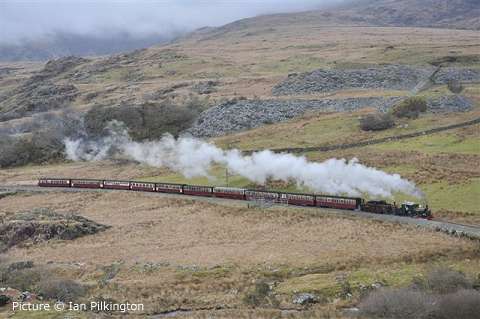
Blanche & Merddin Emrys approach Rhyd Ddu with the 14:30 return special Caernarfon - Porthmadog.
Sunday 21 February: by Ian Pilkington
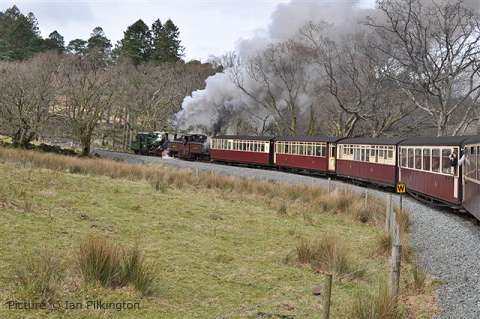
Blanche & Merddin Emrys climb the 1 in 40-48 section through Beddgelert Forest with 10:45 Porthmadog - Caernarfon, the first public train over the complete railway.
Monday 21 February, by Ian Pilkington
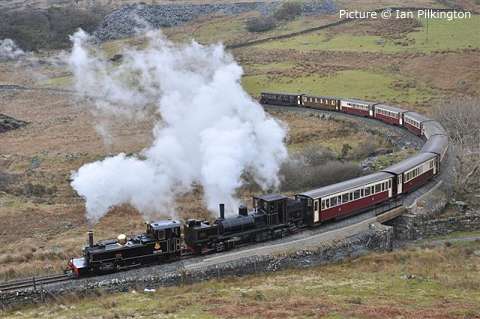
Lyd & K1 approach Rhyd Ddu with the 11:00 Caernarfon - Porthmadog.
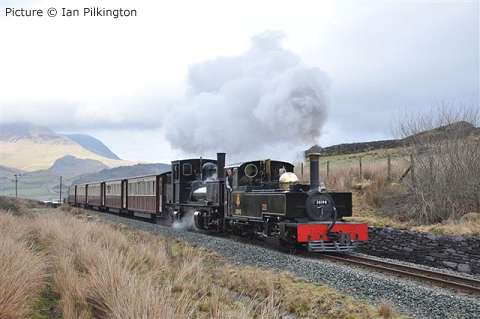
Lyd & K1 approach Pitts Head Summit.
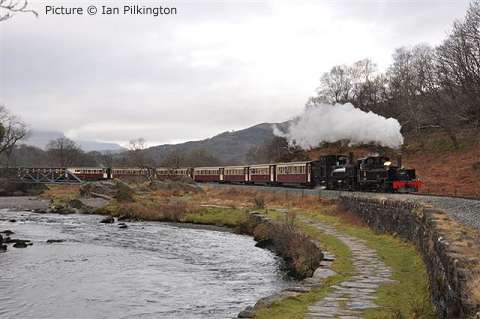
Lyd & K1 enter the Aberglaslyn Pass.
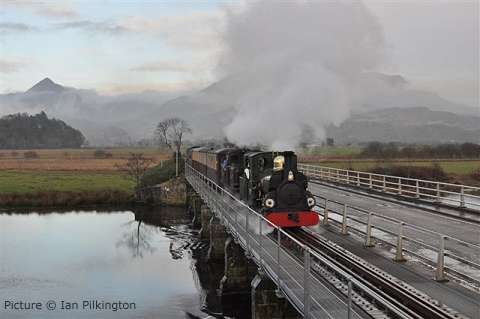
Blanche & Merddin Emrys cross the Glaslyn at Pont Croesor with the 1430 Caernarfon-Porthmadog as the peak of Cnicht emerges from the clouds.
Tuesday 22 February by Siôn Owen
Garratt 138 arrives at Porthmadog on the 11:00 from Caernarfon, negotiating the street-running section.
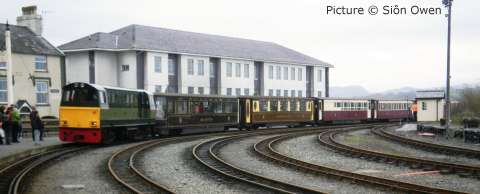
Diesel Vale of Ffestiniog was on hand for the reversal move into the platform.
The street scene from aboard the 14:15 to Caernarfon.
Leaving the street, and heading for the main line crossing.
Class 37/4 news
Recently, DB Schenker advertised all its 13 remaining Class 37/4 locos for sale, most of them having been out of service from some years: 37 401, 402, 405, 406, 410, 411, 416, 417, 419, 422, 425, 426 and 427. Several of these were very familiar in North Wales in the 1990s; it appeared in early February that they had all been sold, DRS being the most likely buyer.
Further developments in the story will certainly be reported as they happen on the excellent 'End of the Line' website www.wnxx.com.
Another look at 31-12-2000 - by Chris Morrison
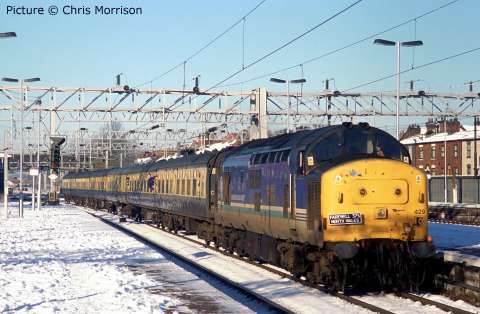
'Dave Trains' great article (3 January issue) on 37 429's last official run up the coast on 30 December 2000 prompted me to look for the transparencies I took that day. After searching the 'vaults' I found them. Above, 37 429 Eisteddfod Genedlaethol runs into Stafford on 1G96 08:53 Holyhead- Birmingham New Street.
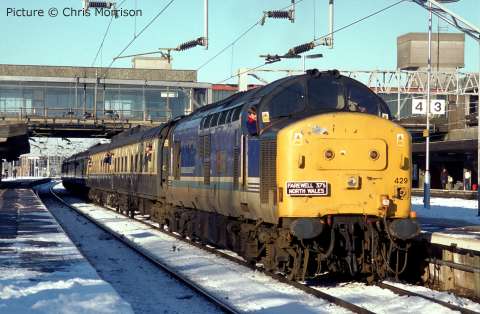
Cameras at the ready on the train, as 37 429 waits for the off at Stafford on 1G96 08:53 Holyhead - Birmingham.
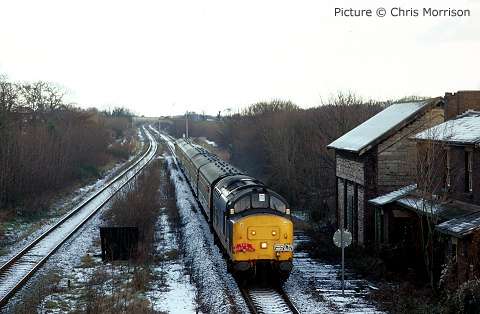
37 429 heads 1D71 12:07 Birmingham - Holyhead into Prestatyn, with Dave Trains driving, past the original station building.
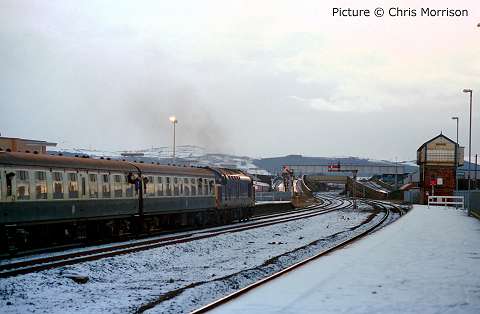
37 429 powers away westward from Rhyl with 1D71.
Picture miscellany
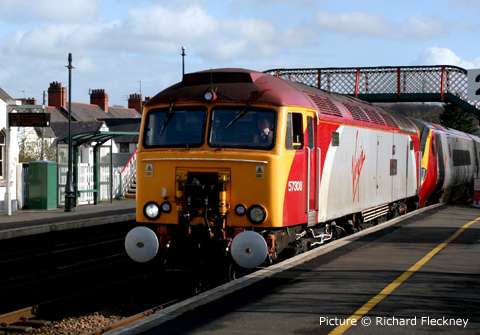
57 308 Tin Tin and Pendolino 390 026 forming the 08:50 London- Holyhead 'drag' head across Anglesey, passing Llanfair PG (Richard Fleckney)
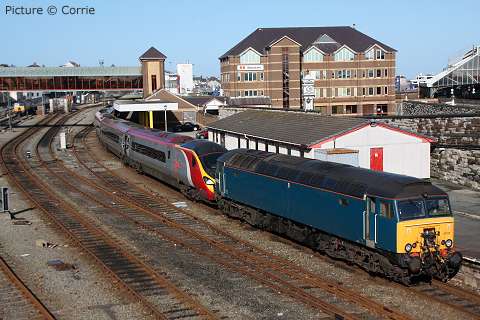
Saturday 26 February saw 57 313 on the eastbound 'drag' seen above ready to depart Holyhead (Picture by Corrie) ...

... and hurrying through Llanddulas (Darren Durrant)
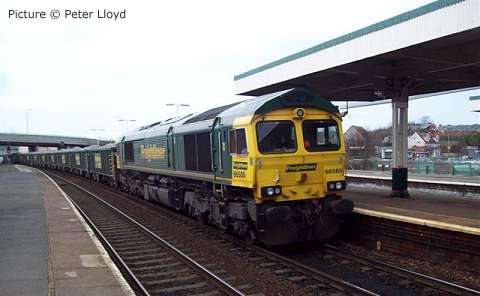
Train 6H45 Penmaenmawr - Guide Bridge, with 66 545 The Drax Flyer crawls through Llandudno Junction at 14.55 on 22 February with a ballast train for Guide Bridge (Peter Lloyd)
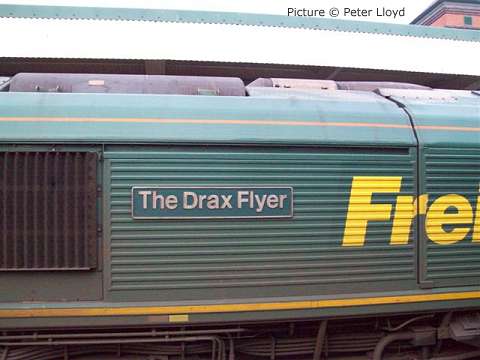
Great name for a loco (?). Picture by Peter Lloyd.
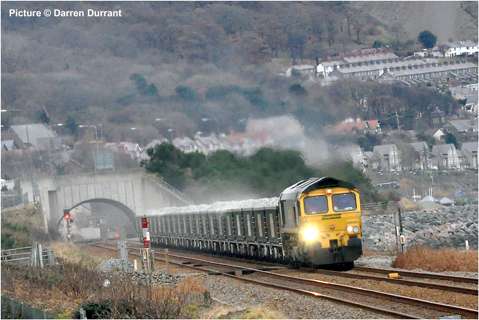
Stone train. 25 February (Darren Durrant)
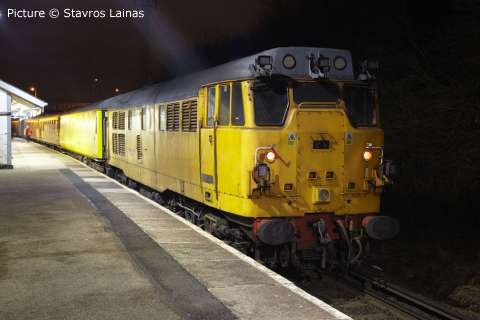
The Network Rail track recording train, 1Q06, at Bidston, 24 February, 21:22. Lead loco is 31 233 (Stavros Lainas)
Sealand narrow gauge mystery - by John Murray
On 22 February I was on my way to an appointment at Deeside industrial Estate at Sealand. Alighting from the bus on Welsh Road I set about walking the short distance along the Millennium Greenway route which uses the track bed of the former Great Central Railway Chester Northgate to Hawarden Bridge line towards the estate.
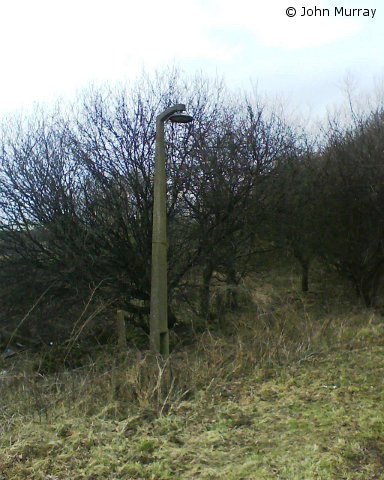
First I came across a surviving lamp standard from the former Sealand station. This halt opened as Welsh Road in 1918 for military personnel at the adjacent RAF Sealand base only, before becoming a public station the following year (above).
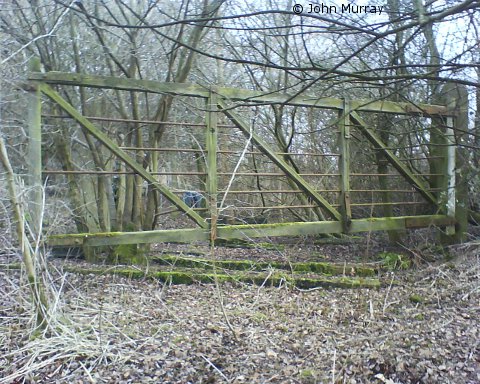
Just beyond the station site the remains of goods yards and the remains of a set back siding leading into the base was evident on the left. Now surrounded by trees, a gate marks the point where the standard gauge line entered the camp. (above).
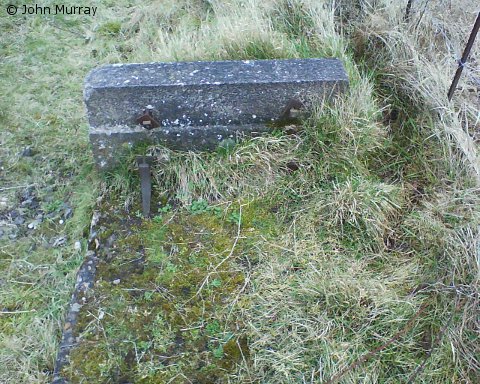
About 250m further towards Hawarden Bridge, I came across narrow-gauge railway buffer stops on my left (above) followed by a length of track mounted on a concrete base (below).
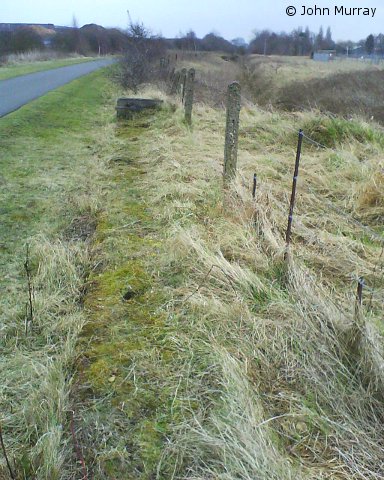
The heavily overgrown track (you have to stand on the ground to find the rails beyond the concrete base to find it) appears to continue parallel to the main running lines before deviating off south under the railway fence onto MOD property. I would estimate the gauge to be two feet or slightly less.
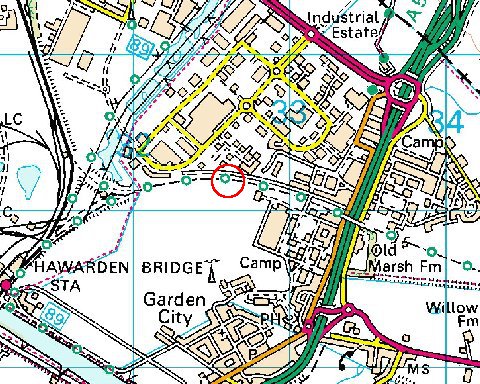
I have circled the location of the buffers on the attached OS Map from Ordnance Survey's Get-a-map service (Image reproduced with permission of Ordnance Survey and Ordnance Survey of Northern Ireland).
A former serving airman at the base told me that he thinks the line is part of a once extensive internal narrow gauge system within the camp used to transfer aircraft components, and other supplies between the camp buildings, the main railway line and the aircraft hangers at the far end of the camp. It was disused by the time he served there in the 1970s and 80s. Finding out more from old maps is a fruitless exercise as the RAF base just doesn’t exist. This was the norm with most military facilities.
Looking at a Google maps satellite image of the location the remains of what looks like the bank of a former narrow gauge railway can be seen north of the camp moat. The piece of track I found appears to be a siding, as the railway line looks like it continues towards Sealand station goods yard and the main camp entrance as my friend suggested. The line looks like it may have continued around the perimeter of the airfield to the Hawarden Bridge landing stages on the river. Unfortunately farming and more recent building developments have removed traces of the route beyond the former triangle junction with the Borderlands Line.
According to various military history websites the camp operated as a packing depot, from 1929, where aircraft were crated before being shipped abroad. This adds further justification to the need for an internal railway system and the link to the docks. Intriguing! Does anyone know anything about the line, the rolling stock used, and perhaps photographs of the railway in use?
References: More about Sealand station on the Disused stations site ; More about RAF Sealand on Wikipedia and BBC North East Wales.
Ferry news - from the Irish Times
Stena LINE has negotiated a reduction in berthage fees at Dún Laoghaire Harbour in a move which will allow the ferry company to bring its high-speed service back into service for the summer. However, the company has told staff at the port that even with the reduction – which is subject to ratification by the board of Dún Laoghaire Harbour Company – the service may become seasonal from September.
Neither side would confirm the reduction in annual fees, but it is understood to be a drop from €6.5 million to €2 million. If approved by the harbour company board next week the agreement would come into effect on April 1st and last for three years.
Stena has been divesting itself of its high-speed ship (HSS) in recent years and is actively looking for a smaller vessel on the Dún Laoghaire-Holyhead route. The HSS has been mothballed in Holyhead over the winter and has been replaced on the route by the smaller vessel, the Stena Lynx, on loan from the Rosslare to Fishguard route.
A significant difficulty is that facilities at St Michael’s pier in Dún
Laoghaire are not configured for conventional car ferries. Any replacement ferry would have to be another fast craft and the business case for such a fuel-dependent vessel is understood to be uncertain.
Stena has two conventional ferries serving Dublin port. There are also Irish Sea crossings to Britain from Belfast and Rosslare.
In the light of declining traffic on the Holyhead route, the harbour company has made no secret of its interest in the cruise line business.
Chief executive Gerry Dunne has said plans were being made to attract cruise liners with a capacity for up to 5,000 passengers. The plans are being supported by Dún Laoghaire-Rathdown County Council as well as the local chamber of commerce, retail and tourism interests and will be advanced by a new master plan being drawn up for the harbour.
A spokeswoman for the harbour company said a statement on the future agreement between the harbour and the ferry company would be issued after the harbour company board meeting next week.
Clearing the Amlwch line
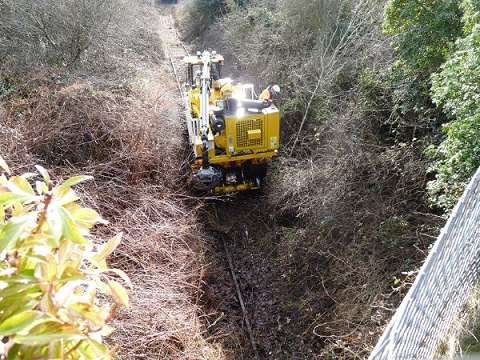
As mentioned before, contractors have been clearing vegetation from the disused Gaerwen - Amlwch branch, as part of a feasibility of re-opening the line, at lease as far as Llangefni. A road-rail vehicle is used, which first has to clear a path for itself!
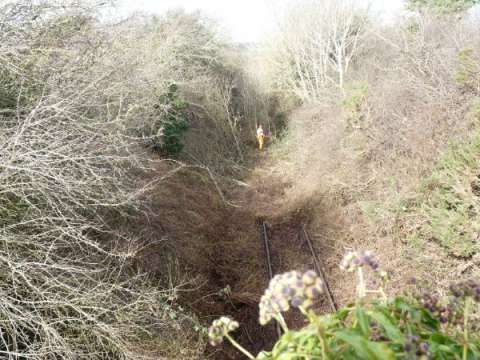
The idea seems to be to check for any rare plants or animals lurking among the trees that might require protection. These two pictures (above) of the early stages of the works, taken looking north from a lane at the rear of 'Matthews Auto Salvage' located some quarter of a mile north of the A55 expressway, show how overgrown the line has become.
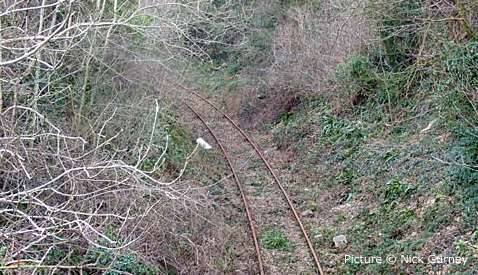
A cleared section at Pentre Berw.
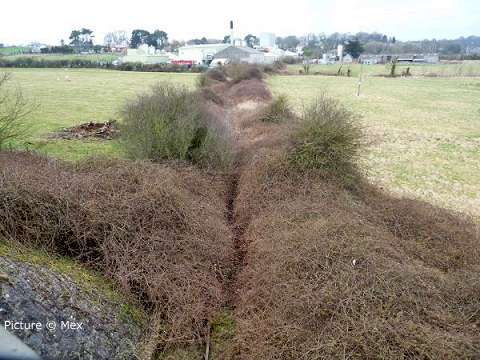
An idea of the task can be gained from this view taken from an overbridge leading from the A5114 to LLangefni Industrial Estate, looking towards Llangefni.
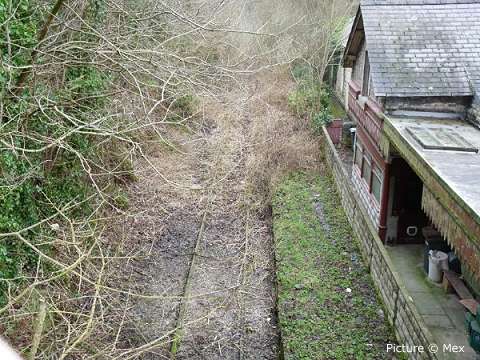
This is Llangefni station.
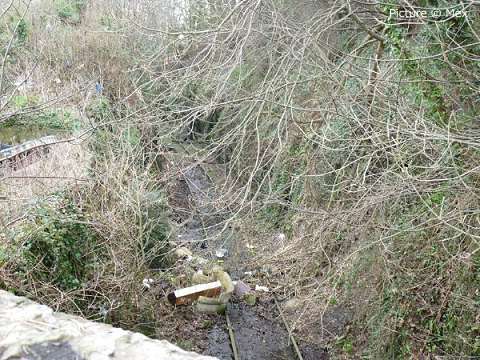
The cutting to the approach of LLangefni station.
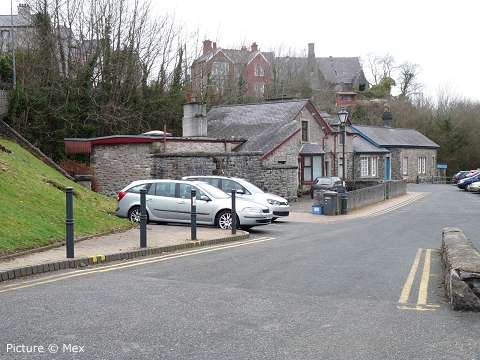
The public side of Llangefni station.
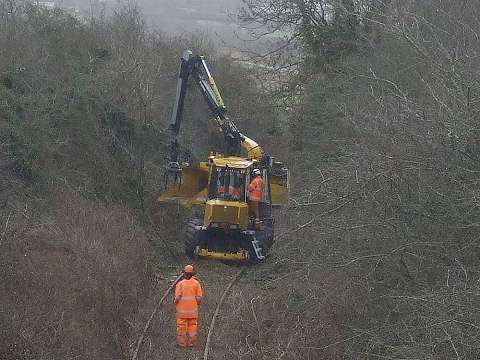
The clearing team nears Llangefni on 24 February.
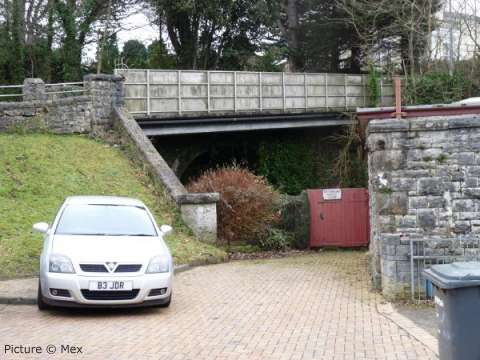
A view of the B5109 overbridge at Llangefni station.
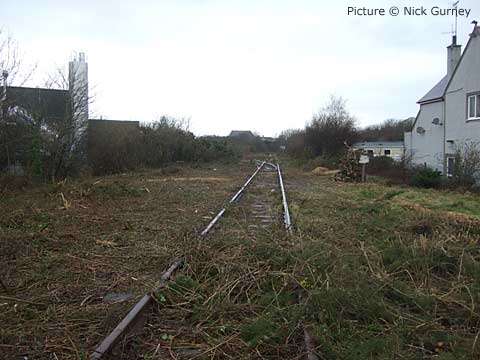
Strangely the line in Amlwch town up to where it crosses the A5025 has also been cleared over the last weeks and a lot of clearing has taken place by - we are told - people doing community service. For what reason it has been cleared we don't know, yet.
Pictures by 'Mex' and Nick Gurney.
North Wales Coast home page Archive Previous Noticeboard